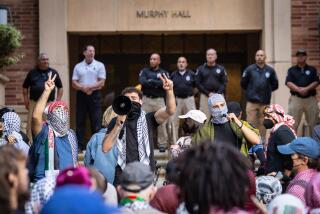UC Will Increase Its Supervision of Nuclear Weapons Laboratories
- Share via
The University of California will beef up its supervision of the two nuclear weapons laboratories it manages for the federal government in hopes of eliminating past problems of pollution, drug use and political lobbying, UC officials announced Friday.
Three senior “liaison officers” will be added to the staff of UC President David P. Gardner to bolster the university’s management of the Lawrence Livermore National Laboratory and the Los Alamos National Scientific Laboratory. The university hires the lab directors but some legislators and other critics complain that UC has done a poor job of monitoring the labs’ work with the one staff member assigned to that task now.
“This increased staffing expands the university’s management of the laboratories. We hope, as a result, to become better informed of laboratory issues, respond to them in a more timely manner and, in general, exercise our management responsibilities more effectively,” Gardner told the UC Board of Regents, meeting at UC Irvine.
Also Friday, the regents unanimously--and with no discussion--approved the start of planning for expansion of existing campuses and the possible addition of three more campuses by the year 2000 to accommodate growing enrollment. A regents committee approved the move on Thursday.
Earlier this year, the state Legislature passed a resolution attached to the UC budget that called on UC to improve its oversight of the enormous labs to make sure the work done there is scientifically sound, impartially presented to government officials and allows for dissent.
The author of the resolution was Assemblyman Tom Hayden (D-Santa Monica), who is chairman of the Assembly Subcommittee on Higher Education. Hayden was vacationing in the Philippines. In a statement issued through an aide, Hayden called Friday’s announcement “a significant step toward assuring protection of dissent and accountability” at the labs. He urged the hiring of “persons of independent judgment, knowledgeable about classified projects and faithful to the standards of a great university.”
Oversight Sparse
At a press conference Friday, Gardner said the steps “very well might have been taken earlier.” He conceded that the amount of lab oversight now is very sparse compared to what is done for the nine regular campuses of the university.
The Hayden resolution is not binding, but UC officials clearly want to protect their budget, which is controlled by the Legislature and governor.
During the meeting in Irvine, UC Senior Vice President William R. Frazer said the oversight mechanism is similar to the Hayden proposal except in one respect. He said it is “overwhelmingly likely” that the new overseers will be former or current employees at the labs because they will have to understand the very complicated scientific projects there. Hayden’s proposal, attempting to avoid any conflicts of interest, specified that the new staffers should not have any past affiliation with the labs.
The university’s relationship with the labs began in World War II but has received more scrutiny recently because of a series of controversies at Livermore. UC receives nearly $2 billion a year from the U.S. Department of Energy to run the labs, which employ a total of 15,000 people.
In the last few years, critics charged that Livermore officials exaggerated the technical progress on the Strategic Defense Initiative, or “Star Wars” program, to ensure more funding and improperly lobbied members of Congress to vote against further limitations on underground testing of nuclear weapons. A report by the federal General Accounting Office said the lobbying was not illegal.
Congressional hearings were held in June about allegations that Livermore administrators ignored signs of drug use by employees and later tried to hush up an investigation; administrators denied the charges. Six lab workers were arrested and 12 others resigned as a result of an investigation two years ago.
In addition, a government report recently found that Livermore’s sewage system may be leaking toxic and radioactive waste into ground water.
Livermore is about 35 miles east of Oakland. Los Alamos, where the first atomic bomb was developed, is about 30 miles north of Sante Fe, N. M.
On the campus expansion issue, some observers were surprised by the lack of debate Friday. Some regents had questioned the expansion when it was first raised last month. However, Regent Jeremiah F. Hallisey, chairman of the educational policy committee, which will oversee such decisions, said the regents want at least one more campus and they believe planning should proceed.
More to Read
Sign up for Essential California
The most important California stories and recommendations in your inbox every morning.
You may occasionally receive promotional content from the Los Angeles Times.











